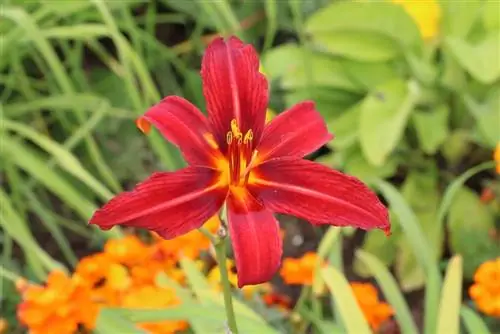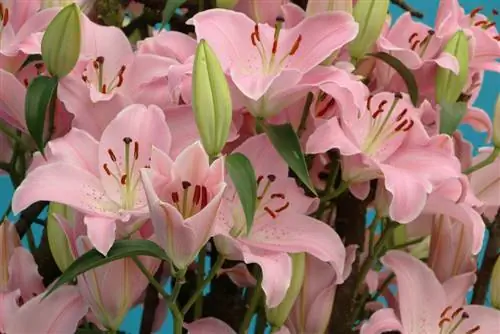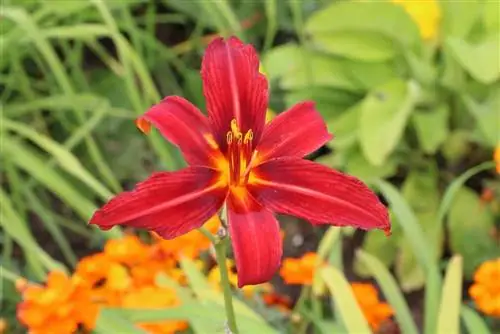- Author admin [email protected].
- Public 2023-12-17 03:39.
- Last modified 2025-01-24 12:45.
Lilies have something majestic about them and they come in so many different forms that it's hard to understand them all. They are very popular because of their artistic beauty and quality as cut flowers.
The motto applies to all lilies: “Keep your feet cool, head in the sun.” This means that their flowers like a sunny spot in the garden, but the lowest leaves should be shaded a little (e.g. by other plants).
Location and soil requirements
The bulbs of the extraordinary beauties are planted in September and most varieties bloom in June/July. They are undemanding when it comes to soil, although it should be permeable and a little rich in humus. They cannot tolerate waterlogging.
Some species such as Lilium testaceum or the pure white Madonna lily love lime-rich soil, while the Japanese gold ribbon lily, Lilium auratum, which also tolerates partial shade, would die in the same soil. Therefore, when buying onions, it is important to read the package or ask what type of soil the respective variety prefers. Lilies love to stay in the same location for several years. Only then will they show what kind of flowering power they have. That shouldn't be a problem since the onions are sufficiently hardy.
Lilies for borders
Tall-growing lilies such as the yellow-flowering Lilium regale, which grows to a height of up to 100cm, are best placed at the back of a border so that they can be supported by taller perennials. An absolute eye-catcher in every perennial bed is the Lilium Oriental Dizzy, which is also 100cm high and blooms persistently from June to August. Its pure white petals have a red line running through the middle and are covered in small black dots. The red-flowering Lilium Amabile, with its height of 80cm, can also need support.
Low-growing lily varieties such as the bright white lily Siberia, which blooms very profusely from June to July, remain under 60cm. Some varieties, such as the orange-red, dark-brown spotted tiger lily Lilium tigerium, which grows up to 150cm high, form roots not only on the bulb itself, but also above the tuber, which is why they are also called stem-rooted lilies and have to be planted approx. 15cm deep. The other varieties are planted 8-12cm deep depending on the growing height. Cardiocrinum giganteum, the white-flowering giant lily, is 250cm tall and can be classified as a solitary plant. Low ground cover plants fit perfectly here.
Lilies for flower boxes
Small lily species such as Lilium punilum with orange-red flowers and strongly curved petals or Lilium canadens with hanging yellow flowers can be perfectly placed in a flower box with e.g. B. Combine violets. For a box 21cm long, six onions are enough, arranged around the edge. From June onwards, they create a picture that is not only colorful but simply pretty, because the violets bloom tirelessly and the lilies, which have faded after a while, proudly tower above them. If you are fond of fragrant flowers, the color miracle Black Beauty with pink and white is for you speckled petals. At least as unusual and strikingly beautiful is the orange electrics, which feature a play of colors of white and orange. Both, like the rarity Lollypop, with large, flawless white petals, which turn into a dark pink from the middle to the edge, are noble lilies that advertise their lovely scent from June to August at a height of 60-80cm.
“False” lilies
But be careful when buying: Some German names for flowers are misleading. Some other bloomers are also called lilies, although they are by no means one of them. For example, the iris is also known as the iris and daylilies are Hemerocallis hybrids that are very similar to lilies, but do not belong to the genus. The well-known yellow-orange-red flowering torch lily is a summer-flowering perennial and does not belong to the Lilium genus any more than the no less well-known and popular white or blue African lily.

Apart from roses, lilies are one of the most magnificent and majestic flowers a garden has and they are available in such a variety that there is sure to be a suitable variety for everyone.
Setting conventional lily types
Lilies prefer a bright, but not too sunny location in the garden. It is best to keep them somewhat protected so that their flowers do not fall off in wind or heavy rain. It is important to ensure that the soil is well-drained so that no waterlogging can occur, which can harm these flowers. To achieve this, a very dense soil can be improved with some gravel or sand.
Lilies like the sun, but prefer their root area to be shaded. Therefore, they can be easily planted with low ground cover plants such as cushion phlox or thyme, other perennials or summer flowers. Alternatively, the ground area can also be covered with a layer of bark mulch.
Depending on the size of the lily bulbs to be planted, planting holes should be dug to a depth of 15 to 25 centimeters. The basic rule here is that the planting hole should be two to three times the size of the bulb. Lilies look particularly beautiful in groups, so several lily bulbs can be planted close together. As a rule, a distance of 10 to 15 centimeters is sufficient, but a little consideration should be given to the height and width of the selected variety so that each plant is shown to its best advantage. In gardens with voles, it is best to plant lily bulbs only in wire baskets, as voles love to eat these bulbs.
In winter, the lily bulbs can stay in the garden because they are hardy. However, if they have been planted in a place where the ground gets very wet in winter, to be on the safe side they can be removed from the ground and stored in a dry and cool place, preferably in the basement, until the next spring. When the ground is frost-free again in spring, you can return to the garden.
Setting the Madonna lily
The Madonna lily is planted in August or September. In contrast to other lily bulbs, it is only covered with soil by around two to three centimeters. The Madonna lily also looks most beautiful when several bulbs are placed next to each other; the distance should be around 10 to 15 centimeters. For this type of lily, the soil can be a little calcareous and moist, but the Madonna lily cannot tolerate waterlogging either, so in this case the soil should also be well-drained. The best location is a sunny to partially shaded place where the flowers are protected.
The Madonna lily sprouts in the same year, but it doesn't bloom until the following year at the earliest. It then forms a long stem that can reach more than a meter high and from which hang large clusters with many individual flowers. These flowers are snow white and gave this type of lily its name.
Once the Madonna lily has faded, the flower stalk can be cut off directly above the ground, but as with other lilies, the tuft of leaves must only be removed when the leaves have completely withered. This is important because the lilies use their leaves to store nutrients in the bulbs for the winter and flowering the following year.






